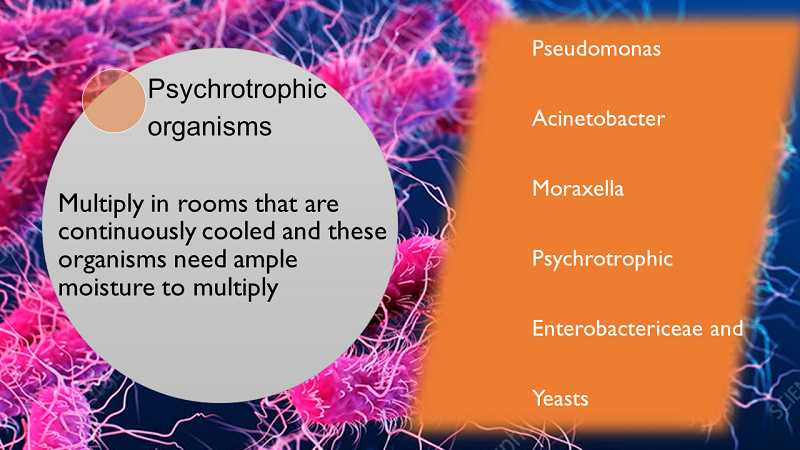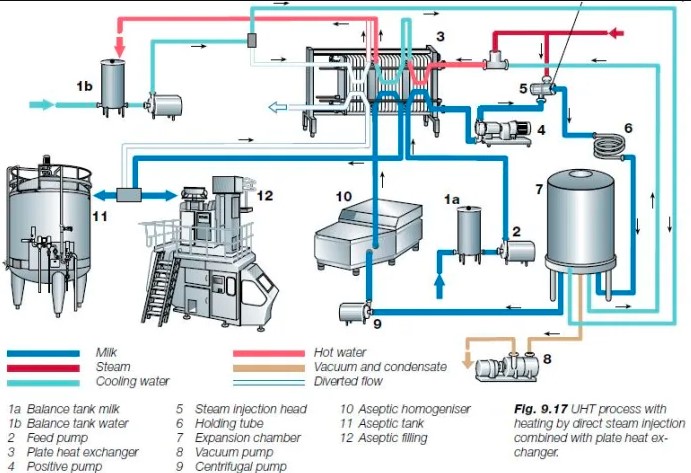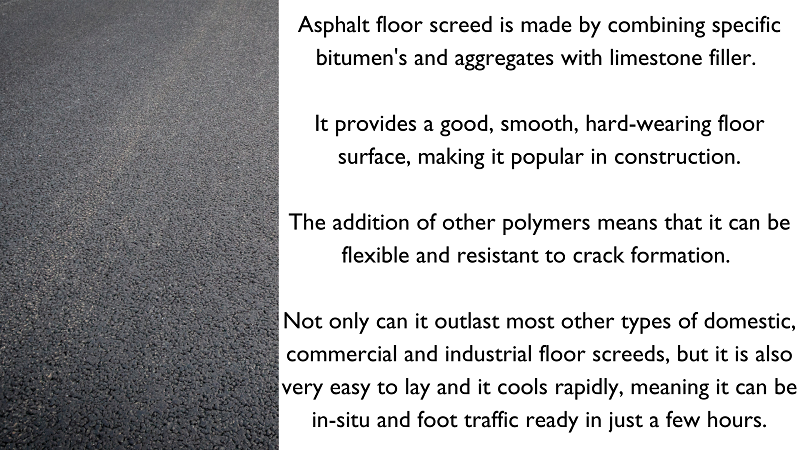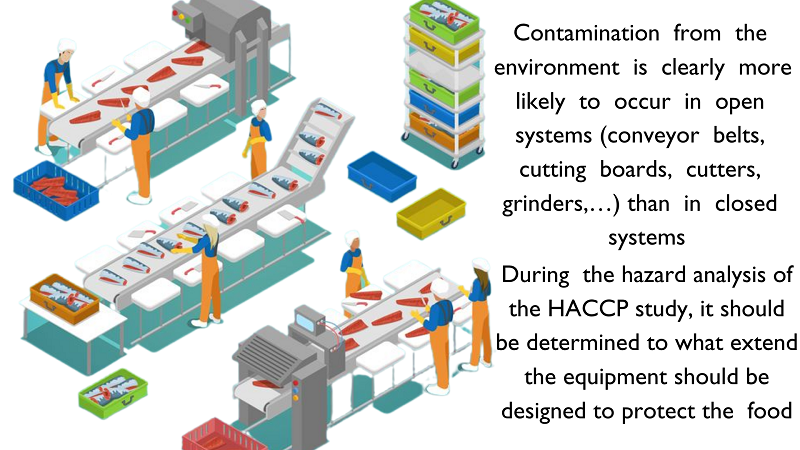Introduction
Foods undergo many operations starting from harvest or primary production to the final stages of distribution, retailing and handling in food service establishments or at home. As well for:
- Production, harvesting and slaughter
- Incoming raw materials
- Processing
- Storage
- Distribution, handling and use in wholesale markets, restaurants and kitchens
- Food-operating areas have to be designed by taking into account all hygienic aspects.
Location and Surrounding Area

Climate can have an important influence on design criteria. For example, the average, minimum and maximum annual temperatures and relative humidity have to be taken into account in the design of facilities and may require different approaches in hot humid climates than in cooler, drier regions.
Serious considerations need to be given to the location of food plants: shoots, woody regions, busy motor-roads or companies that work with strongly contaminated products, have to be avoided. Roads and parking places near the company should have a hard and if possible paved surface and good drainage, to prevent flooding and dust.
The Building
The micro-flora of food processing plants is composed of microorganisms that gain entry from air and water but, more importantly, those brought in by animals, raw materials, dust, equipment and people. As operations proceed, there is an accumulation of a typical flora associated with conditions in the plant and with the types of processes and products. This may occur in places that are not readily accessible for cleaning.
The development of a micro-flora at a given site is determined predominantly by the availability of nutrients and water and by the pH and temperature. Of these, water and temperature will be influenced the most by the design of operating areas. In most food companies a lot of water is present by which a humid atmosphere is created especially in cavities, niches, crevices, and other sites, that are conducive to the multiplication of microorganisms. For the maintenance of satisfactory hygiene, structures should be designed to facilitate drying and to prevent the persistence of moisture.
The type of flora that will develop often depends primarily on the prevailing temperature.

Accordingly, these rooms must be designed in a way that excess moisture can be easily and rapidly removed. In warmer areas effective ventilation and a design that removes excess heat, steam, aerosols and smoke are of particular importance.
Arrangement of Rooms, Areas and Processes within Establishments
Raw material, partly processed material and waste can contaminate the end product. A suitable arrangement of rooms and of the various sections of processing areas may help to prevent cross-contamination. To achieve this, it is essential that the architect consults a microbiologist or hygienist before designing a food operating area. The division in sections has to allow a logical process, step-by-step, from delivery of raw materials to production and finally to packaging. The division has to be designed in a way that contamination from one area or section to another is not possible.
A strict separation of rooms with a low-risk factor, the 'low risk' area, and rooms with a high-risk factor, the 'high care' area are of prime importance. 'Low risk' areas are those in which contaminated raw materials are handled e.g., delivery, unloading and unpackaging, holding and slaughtering of animals, washing and peeling of vegetables. 'High care' areas are those in which any contaminant, added to the product carry over into the finished products i.e., there is no subsequent processing step that will destroy contaminating microorganisms. To avoid cross-contamination, food products in a certain stage of production may not come into contact with food products in a less processed stage. The same principle applies to the personnel, which is only allowed to work in different productions stages after washing and decontamination of hands and changing of clothing.

In some cases, ‘high risk’ areas are demanded, where every possibility of cross or post contamination needs to be avoided e.g., during aseptic filling of UHT treated products or during slicing of cooked meat products or filling of cooked meals. In this case, extra requirements are posed on the surroundings and personnel e.g., overpressure in the area, filtered air, change of clothing of personnel before entering, protection of breath by a mask, etc.
Cooled rooms must be separated from hot areas, which accommodate heat processes such as retorting, cooking and smoking.
Dry rooms should be partitioned from damp rooms where steam and humid air develop. Wet rooms usually require higher standards of hygiene (design, construction elements and their maintenance) than dry rooms.
Structural Components
Floors are usually contaminated with large numbers of microorganisms and must therefore be designed for easy cleaning. They should be constructed with waterproof, non-absorbent, washable material without fissures or crevices. Floors made from stone, asphalt or tiles are suitable, particularly in rooms where the floor is constantly wet or washed frequently.

Smooth surfaces will facilitate thorough cleaning but are often slippery, particularly if the floors are wet. Non-slip surfaces may be required in some areas for occupational safety but may make effective cleaning difficult.
Angles between floors and walls or floors and bases of columns should be sealed and coved. This will prevent the accumulation of dirt and moisture. If frequent wet cleaning is required, floors should slope towards the drain so that the water excess can easily be removed.
Walls should have coverings of impervious, washable material or be constructed of material coated with an impermeable varnish up to a certain height. The surface should be smooth, without crevices. Joints between adjacent walls and between walls and ceilings should be sealed.
Ceilings are unlikely to come into contact with foods and are rarely cleaned. Therefore, they should be constructed to prevent the accumulation of dirt and dust.
The provision of adequate air circulation has first priority in the prevention of mould growth on ceilings. Condensation dripping from ceilings is a potential cause of contamination of foods underneath. Ceilings often consist of absorbent substances such as plaster. These materials tend to become mouldy as they accumulate moisture. Mould growth can be reduced by ventilation and air conditioning. The application of fungicidal paints will supplement these measures.

Windows accumulate dust, are difficult to clean and, if opened, permit entry of dust and vectors of microbial contamination. Therefore, food-handling areas should preferably be designed without windows. Where windows or other openings are required, they should be constructed to avoid the accumulation of dirt and dust. Openings should be fitted with removable screens to exclude insects and vermin.
Doors must be tight fitting to exclude rodents, insects and dust. They should have smooth, non-absorbent surfaces. Doors leading to food processing areas could provide avenues of cross-contamination when touched by bare hands. To minimise this risk, these doors should be fitted with mechanisms for automatic opening and closing.
Pipelines should be constructed of material with a smooth surface and should be easily removable to facilitate cleaning or should be covered with washable paint. They may not be leaking.
Control of Environment and Measures to Protect the Product
Lighting: The type and intensity of artificial illumination in food handling areas have little effect on microbes contaminating foods. However, adequate lighting is essential to permit recognition of gross soiling and to monitor by inspection the efficacy of cleaning. Lighting can be natural or artificial and may not alter colours significantly.
Following intensities are recommended:
- Global light intensity: 400 lux
- At inspection points: 600 lux
- In storage depots: 250 lux
Light bulbs and fixtures should be safe and installed so as to prevent contamination of foods in case of breakage. All light fixtures must be protected with plastic shields or treated with a special coating.
Effluent disposal: It is of high importance that cross-contamination through the wastewater system is avoided. An optimal system has two separated waste pipes, one for 'low risk' areas and one for 'high care' areas. The two parts can only be joined by inlets of the underground main canal, which are equipped with shutoff valves.
When a complete separation of the wastewater pipes is impossible (when the wastewater pipes of the 'high care areas are directly joined to the parts of the 'low care' areas) the wastewater pipes have to flow away from the 'high care' area and contain sufficient shut-off valves. Drains should be fitted with traps to control odours. The culverts have to be equipped with removable grids. The grids may only be taken off to be cleaned.
Storage deposits: Raw materials meant for the production of food products and also recipients and packaging materials meant for containing food products, have to be stored in a way that they are protected against microbial or other types of contamination. Dusty rooms, which are difficult to clean, are not suitable for storing goods.

Packaging materials meant for single-use have to be delivered in a hygienic way: a plastic inner packaging is surrounding the product before a paperboard function as secondary packaging. Used recipients can only be applied for the packaging of food products if they are cleaned in such a way that their use does not result in microbial or chemical contamination nor creates an undesired change of the organoleptic properties of the food products. All residues of food products and other impurities like strange objects have to be removed from the recipients. Recipients, who are not complying with this, like new or used recipients that are damaged, should be destroyed.
The integrity of structural components and apparatus: Floors, walls, ceilings and all other components of the rooms, just like objects which are situated in the rooms, may not contain spots of moulds, rust and flakes of paint. Furthermore, they should be maintained well and cleaned at regular times.
Storage of toxic materials: In a company that produces food products, only these additives, which are allowed to be used in the produced food products, may be present in the rooms.
All other toxic or dangerous components may not be found in the rooms in which food products or packaging materials are present. Cleaning and decontamination products need to be stored in a separate room, which is not accessible for all persons.
Sanitary and Clothes Changing Facilities
Each company is obliged to have a specific room for changing normal clothing to work clothing.
Clothes changing facilities should be clean and neat and may not be used as a refectory or smoking room. The cupboards must have a part for normal clothing and one for work clothing. There should be a separate rack for cleaned work clothing.
Toilets
There should be enough toilets for the number of staff employed. Toilets should not open directly into food handling areas to reduce the risk of contamination of food processing areas. The doors should close automatically. Toilets should be fitted with water flushing. Flushing handles are often a source of contamination, and hand contact can be avoided by the use of foot pedals.
In each lavatory, an inscription, which obliges hand washing after use of the lavatory, has to be applied in a clearly visible and indelible way.

Hand Washing Facilities
Hands are often contaminated by contact with raw materials carrying pathogenic or spoilage organisms. Furthermore, people working in food operating areas may often be unwitting carriers or executors of Salmonella or other infectious organisms. To reduce contamination from such sources, adequate and conveniently located facilities for hand washing and drying should be provided. Handwashing facilities must be located conveniently to each toilet room and positioned so that the employees must pass them when returning to the processing areas. Handwashing facilities must provide cold and hot flowing water or premixed water at a specific temperature, a reservoir of washing and decontamination products for the hands and towels for single use. Roller towels are allowed if they roll automatically and if the used part is separated physically from the clean part. Installations blowing warm air are only allowed in rooms where food products are absent. Taps of non-hand-operable type are desirable. The facilities must be fitted with properly trapped waste pipes leading to drains.
Equipment
When selecting food-processing equipment, a number of factors should be considered. Foremost of these is how well the equipment performs the intended function. The next major concern is cost. The selection process then proceeds to consider the size needed for the volume of the product, reliability, ease of operation and maintenance, compatibility with other existing equipment and safety to operators. Many of the foregoing attributes have an impact on microbiological control since the equipment that is difficult to maintain or that does not perform as expected could cause major microbiological problems.

For the purpose of this chapter three attributes will be considered:
- The equipment must be cleanable.
- Where appropriate, the equipment must protect the food from contamination.
- it must permit monitoring and control.
Cleanability
Parts of equipment parts that come into contact with food should be constructed of durable, non-toxic materials that are resistant to corrosion or physical damage during normal operation. The surfaces should be smooth with no cracks, pits or fissures in which microorganisms could persist and multiply, and should be easy to clean.
Wood and some other fibres are porous and absorb moisture. This permits the migration of microorganisms and soluble food material into the wood where they may be protected for normal cleaning processes. The situation becomes progressively worse with time. For this reason, wood is now prohibited in food companies. It is also recommended to avoid the use of cast iron. This material rusts easily; this creates holes in which small food particles accumulate and provide a suitable medium for microorganisms.
Stainless Steel is the best material for food equipment because of its smooth, impermeable and easy to clean and disinfect. The resistance to corrosion depends on the composition. It is important to select the appropriate grade for each particular food use so that scarring and pitting of the surface will not occur.
Rubber and rubber compounds are widely used in the food industry for seals, fittings, hoses, conveyor belts and other applications. It should be recognized that rubber has a limited operational life and frequent inspection, and prompt replacement may be necessary.
A recurring problem of cleanability in food equipment is the placement of monitoring, control and recording devices. Thermometers, pressure gauges, thermocouples, hygrometers etc. must be in contact with the food, but they may not impede the product flow or provide holes where food residues and microorganisms accumulate. Sampling ports are another potential problem. They must be constructed to minimise contamination during use and must be readily and effectively cleaned and disinfected between uses.
Protecting the Food
Equipment for handling, preparing and storing food must be designed and used so that the food will be protected from contamination. The contamination can come from either outside or inside the food equipment.
Examples of environmental contamination include condensate on the ceiling, contaminated air and water splashing from the floor onto food contact surfaces. Ideally, the contamination should be eliminated e.g., the formation of condensate on the ceiling can be prevented with a good ventilation system, the air can be filtered and provided under positive pressure to the work area and the use of water can be controlled. For various reasons, however, corrections may not be possible or completely effective. Therefore, it can be necessary to install gutters to catch and carry away condensate and covers may have to be installed over kettles and conveyor belts.

Closed processing systems minimize contamination from the environment, yet there remain sites of potential external contamination. These include the points where food enters and leaves the system and where the parts of the system are joined. The cleaning of such a system occurs via CIP (Cleaning in Place).
Food must also be protected from contamination within the food processing equipment. In both closed and open systems, there can be sites, such as dead ends and void spaces, where food residues accumulate. If the temperature is within the range for growth and viable cells reach the site, microbial growth can occur. This can then lead to continuous contamination of the food as it is being processed within the equipment.
Cooked food must also be protected from contamination by raw food. The ideal layout of the equipment is a straight line with a wall, separating raw food processing steps from the steps where cooked foods are processed. This is not possible in the kitchens of hotels, restaurants, institutes and at home. In those situations, the person must be aware of the need to separate raw foods, particularly raw animal products, from cooked products. There must also be a distinction between equipment used for raw and cooked food. This can be accomplished by using different colours on recipients, chopping boards, carving boards, dishes, vats, scales and other portable equipment. When it is not possible to realise a separation, materials, working tables, tools, recipients and all other objects which have been in contact with raw food products, may - to avoid cross-contamination - only come in contact with cooked food when they are cleaned and disinfected properly.
Devices for Monitoring
It is the essence of a HACCP system that, once CCPs have been identified, they must be monitored. In many cases, the primary monitoring will be by devices that are connected to the equipment. These include thermometers, pressure gauges, flow meters, pH meters, etc. and they can be associated with warning devices such as telltale lights, alarm systems and safety valves. For example:
- Cold storage rooms should have thermometers and hygrometers, connected to recorders.
- Fermenters should have pH or acidity measuring devices.
- Brine baths should have salinometers.
It is not sufficient that devices are provided; they have to be used in an efficient way. Thus, the temperature in a cooling chamber may be less important than the temperature of the food within it. In such cases, thermocouples should be available to measure the temperature of the food. This is important to protect against improper processing due to overloading or failure of the equipment.
Installation and Layout of Equipment
Equipment should be installed in a way that cleanability is maximised. Individual items should be sealed with the floor or at least 15 cm above it. There must be adequate space or access between the walls and the equipment unless the latter is sealed with the wall. Sufficient space has to be available for the present equipment so that the safety of the production is guaranteed.